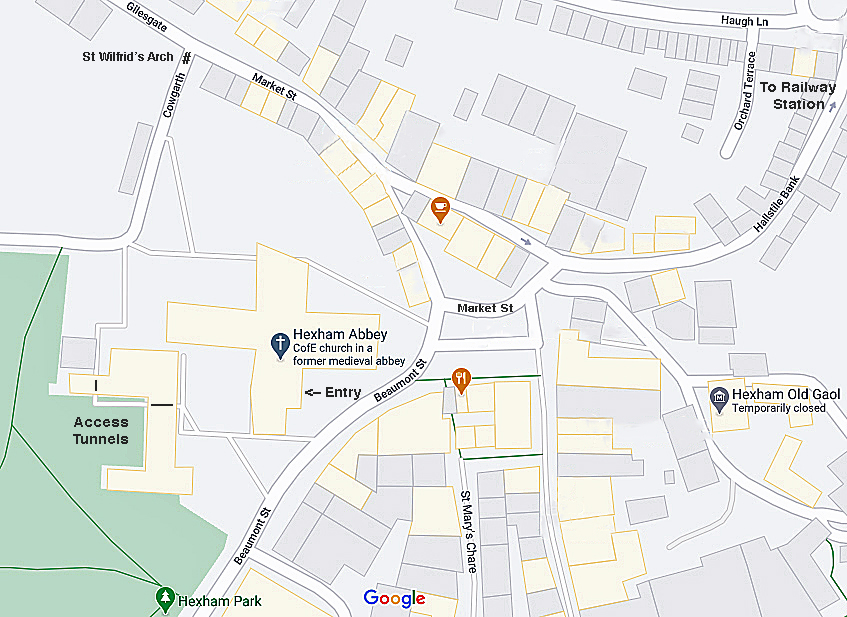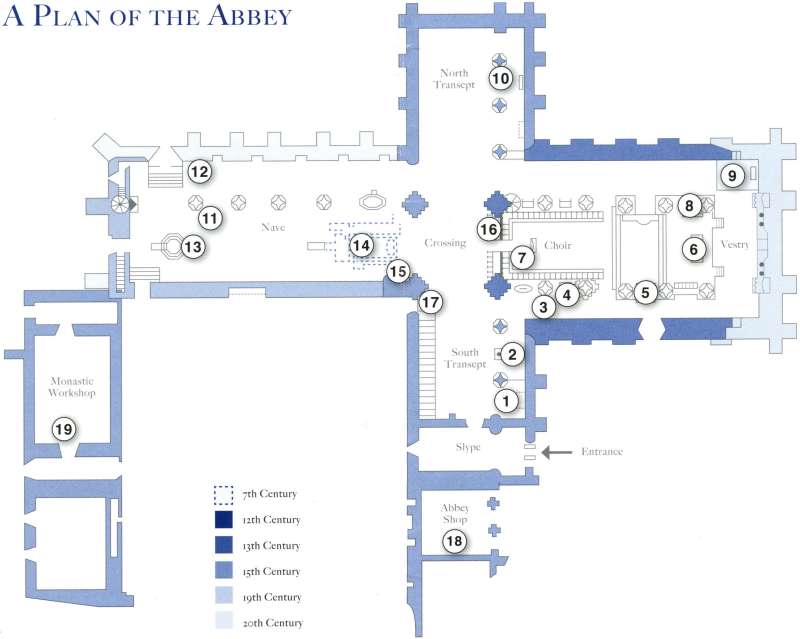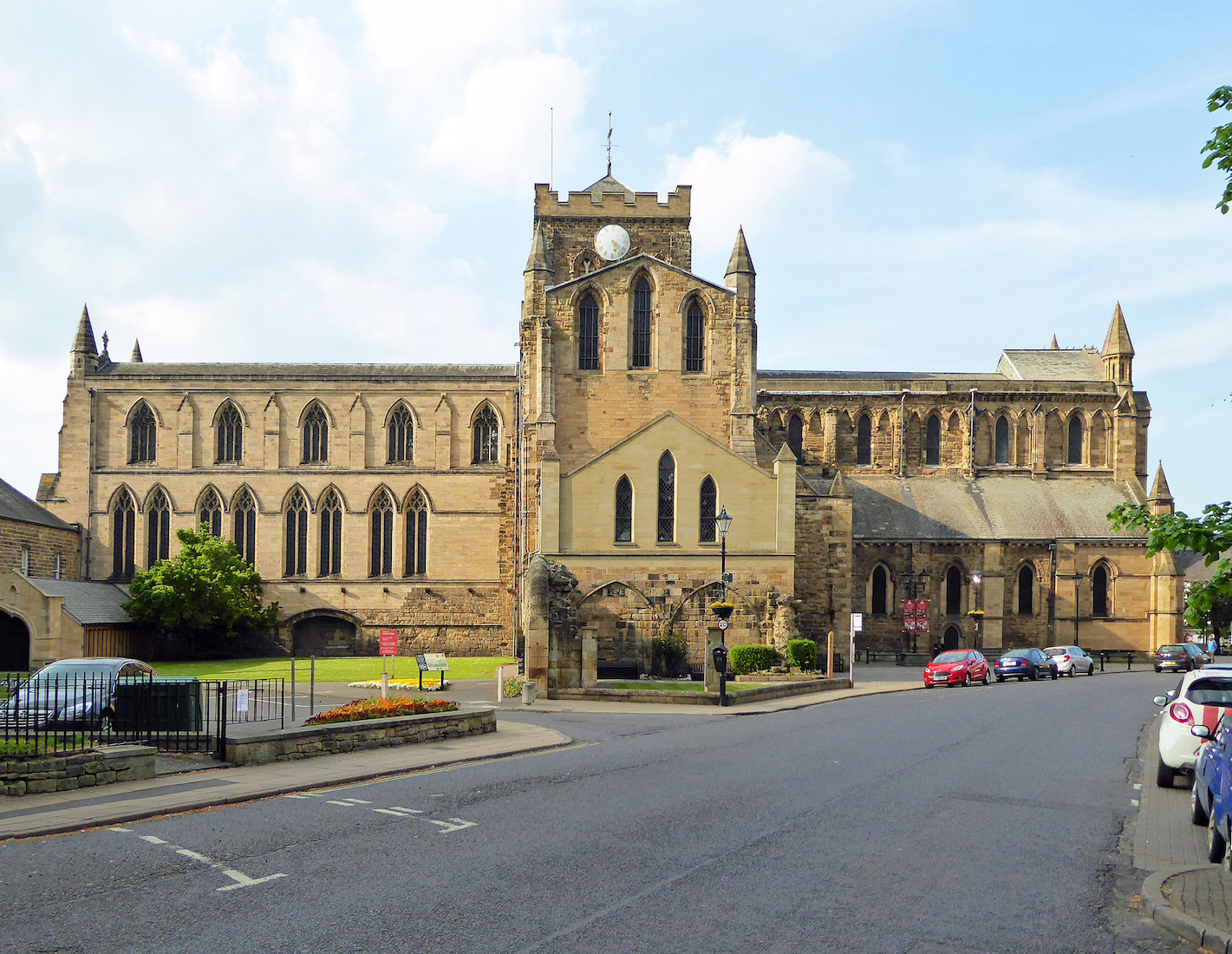A map, a plan, and a brief history of the Abbey are given below. However, if you want to begin your tour of the Abbey immediately, tap / click on START . You can also access intermediate points in the tour by a tap / click on the following links:
NOTE ON MAGNIFYING IMAGES
With this website format the images are large enough for most purposes. If there is a need for greater magnification of an image, go to the identical photo on
https://www.flickr.com/photos/amthomson/sets/72157688993870643/
and download the image as instructed.
SATELLITE MAP
This satellite plan shows how the Abbey sits to the northwest of the town. The railway station is at top right, and from there it is just a short walk to the Abbey. The Abbey sits rather abruptly on Beaumont Street, but beautiful Hexham Park lies to the west, and there is some open space to the north and east.
The Abbey itself is roughly (!) cruciform in shape, with the sanctuary facing geographical east. This means that our liturgical directions (with capital letters, for example East), coincide with the geographical directions.
It is our practice to first walk around the outside of the Abbey: we shall begin at Beaumont Street, near the marked Entry. There is an old monastic building to the Southeast, adjacent to the Park. This contains the Visitor Centre and Refectory. We shall walk through the access tunnels shown, and walk up to St Wilfrid’s Arch, before completing our circuit of the Abbey. (The North transept in fact has a square end!) We then come inside the Abbey through the marked Entry.


PLAN
This is the official Hexham Abbey plan. The Abbey has an excellent set of online resources, which I gratefully acknowledge! On this site, we shall not follow the indicated numbering, preferring instead to start at the Western end of the nave, and make our way towards the sanctuary at the East. However, we will include the Abbey numbering in square brackets.
The Abbey has one particularly unusual feature. We notice that the nave has a single set of column supports, separating the ‘‘main’ nave from the Northern aisle. This asymmetric feature is repeated in the transepts, although here the Eastern ‘aisle’ becomes a series of chapels. The addition of a South choir aisle accounts for the greater width of the chancel.
HISTORY
Years Built: 674 – 681, 1180–1250
Address: Beaumont Street, Hexham
Simon Jenkins Rating: ****
55 Major British Churches: √
673-674 Queen Etheldreda grants Bishop Wilfrid the lands of Hexhamshire for a new Benedictine monastery.
678 Wilfrid’s church is completed.
681 Hexham Priory becomes a Cathedral. Trumbrith is consecrated first Bishop.
875 Viking raiders destroy parts of Hexham monastery.
1113 The Archbishop of York, Thomas II, re-forms the Church at Hexham as a ‘Priory of Canons Regular of St Augustine’, and endows it with land and properties.
1150 The Gateway and precinct wall are erected.
1180-1250 A chancel, transepts and tower are added to the Priory Church.
1296 Scottish raiders set fire to the Priory, destroying shrines, books and relics.
1297 William Wallace – ‘Braveheart’ – carries out another Scottish raid, and attacks the Priory again, destroying what remained after the 1296 raid.
1311 Robert Bruce ravages Tynedale, but stops short of slaughtering the priests at the Church.
1346 The Priory is sacked in another Scottish raid.
1404 The Church receives its first six bells.
1536 Dissolution of the Monasteries. At Hexham, the chancel and transepts survive because they will be needed by the Parish Church.
1538 The Abbey becomes Hexham Parish Church, replacing St Mary’s Church, south of the Market Place.
1725 The Saxon crypt, long since forgotten, is re-discovered by workmen digging foundations for a buttress to support the west side of the tower.
1742 The Abbey’s bells are re-cast, the six old bells becoming eight new ones.
1821 The tower clock is installed, with four faces, each with a diameter of eight feet.
1828 Part of the east wing collapses. It is re-built the following year by Newcastle architect John Dobson.
1857 Restoration of the east wing begins.
1898 Reverend Sidney Savage becomes Rector and embarks on a series of improvements to the Abbey’s structure.
1907-8 The nave is re-built, to the same layout as that of the 13th century. It is consecrated on 8th August 1908.
1910 Electric lighting is installed.
1974 The Phelps organ is installed.
1992 New choir stalls and a circular altar are added at the crossing.
1996 St Wilfrid’s Chapel is created at the east end of the north chancel aisle
1999-2000 Two new bells – Peace and Millennium – are cast by the Whitechapel Bell Foundry, to give Hexham and its Abbey ten bells for 2000.
2014 Restoration of the medieval monastery complex – the Priory Buildings – is completed. This work reunites all the buildings on the Abbey site for the first time since the Reformation, and creates The Big Story exhibition and the Refectory Café.
https://www.hexhamabbey.org.uk/brief-history



